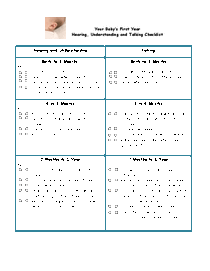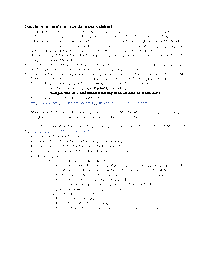Children’s Medical Services
Publications
 Newborn Screening Program 2016 Annual Report – for Professional Support
Children's Medical Services - Report
February 5, 2018
Newborn Screening Program 2016 Annual Report – for Professional Support
Children's Medical Services - Report
February 5, 2018
This document is an overview of newborn screening, screened conditions, types of specimen problems and errors, hearing screening tips and facilities and more information for Professional Support.
 Newborn Screening Program 2015 Annual Report - For Family Support
Children's Medical Services - Report
September 6, 2016
Newborn Screening Program 2015 Annual Report - For Family Support
Children's Medical Services - Report
September 6, 2016
This document discusses newborn screening, screened conditions, and family support for those who have one of the disorders detected by the Newborn Screening Program.
 Report of Audiological Results Form
Children's Medical Services - Form
December 9, 2014
Report of Audiological Results Form
Children's Medical Services - Form
December 9, 2014
This form is used by audiologists to report their audiological results to the New Mexico Department of Health after screening a newborn’s hearing.
 EHDI Advisory Council Meeting 10/03/2014 - Minutes
Children's Medical Services - Meeting
October 3, 2014
EHDI Advisory Council Meeting 10/03/2014 - Minutes
Children's Medical Services - Meeting
October 3, 2014
In collaboration with stakeholders that include but are not limited to parents, screening providers, physicians, audiologists, early intervention providers, the New Mexico Newborn Hearing Screening Program convenes this council with the purpose that is to ensure that all the children in New Mexico receive optimum services related to a statewide newborn hearing screening and intervention program.
 EHDI Advisory Council Meeting 05/02/2014 - Minutes
Children's Medical Services - Meeting
May 2, 2014
EHDI Advisory Council Meeting 05/02/2014 - Minutes
Children's Medical Services - Meeting
May 2, 2014
In collaboration with stakeholders that include but are not limited to parents, screening providers, physicians, audiologists, early intervention providers, the New Mexico Newborn Hearing Screening Program convenes this council with the purpose that is to ensure that all the children in New Mexico receive optimum services related to a statewide newborn hearing screening and intervention program.
EHDI Advisory Council Meeting 05/02/2014 - Agenda
EHDI Advisory Council Meeting 05/02/2014 - Summary
 EHDI Advisory Council Meeting 03/07/2014 - Minutes
Children's Medical Services - Meeting
March 7, 2014
EHDI Advisory Council Meeting 03/07/2014 - Minutes
Children's Medical Services - Meeting
March 7, 2014
In collaboration with stakeholders that include but are not limited to parents, screening providers, physicians, audiologists, early intervention providers, the New Mexico Newborn Hearing Screening Program convenes this council with the purpose that is to ensure that all the children in New Mexico receive optimum services related to a statewide newborn hearing screening and intervention program.
 EHDI Advisory Council Mission Statement
Children's Medical Services - General
December 13, 2013
EHDI Advisory Council Mission Statement
Children's Medical Services - General
December 13, 2013
The Early Hearing Detection & Intervention Advisory Committee is committed to the adoption of Universal Newborn Hearing Screening and Early Hearing Detection and Intervention Programs. Our goal is to facilitate the early identification, diagnosis, amplification and intervention of infants and children with hearing loss in order to maximize developmental outcomes.
 Audiology Survey from Subcommittee
Children's Medical Services - Form
September 30, 2013
Audiology Survey from Subcommittee
Children's Medical Services - Form
September 30, 2013
This survey form helps the New Mexico Early Detection and Intervention advisory council gather current data in order to update the resource list of professionals who provide newborn and pediatric audiology services in our state.
 EHDI Advisory Council Program Summary
Children's Medical Services - General
September 30, 2013
EHDI Advisory Council Program Summary
Children's Medical Services - General
September 30, 2013
This is an annual progress report for budget period July 1, 2012 – June 30, 2013.
 EHDI Advisory Council Meeting 09/27/2013 - Minutes
Children's Medical Services - Meeting
September 27, 2013
EHDI Advisory Council Meeting 09/27/2013 - Minutes
Children's Medical Services - Meeting
September 27, 2013
In collaboration with stakeholders that include but are not limited to parents, screening providers, physicians, audiologists, early intervention providers, the New Mexico Newborn Hearing Screening Program convenes this council with the purpose that is to ensure that all the children in New Mexico receive optimum services related to a statewide newborn hearing screening and intervention program.
EHDI Advisory Council Meeting 09/27/2013 - Agenda
EHDI Advisory Council Meeting 09/27/2013 - Attendance
 Physician Reporting Form
Children's Medical Services - Form
August 13, 2013
Physician Reporting Form
Children's Medical Services - Form
August 13, 2013
This form is used by physicians to report the results of their hearing screen or diagnostic audiological evaluation to the New Mexico Department of Health.
 EHDI Advisory Council Program Update
Children's Medical Services - General
July 10, 2013
EHDI Advisory Council Program Update
Children's Medical Services - General
July 10, 2013
The New Mexico Newborn Hearing Screening Program is designed to oversee the newborn hearing screenings, diagnostic evaluations and referrals to the early intervention process through a tracking system. The program assists in identifying those newborns with hearing loss, as soon as possible, so the ability to develop communication and social skills is obtained at the earliest stage.
 Newborn Hearing Screening Checklist
Children's Medical Services - Form
February 18, 2013
Newborn Hearing Screening Checklist
Children's Medical Services - Form
February 18, 2013
This form helps you track your baby’s hearing, understanding and talking in their first year.
 Newborn Hearing Screening Brochure
Children's Medical Services - Marketing
February 12, 2013
Newborn Hearing Screening Brochure
Children's Medical Services - Marketing
February 12, 2013
This document describes how the diagnostic audiological assessment process works.
 Diagnostic Audological Assessment
Children's Medical Services - Help
February 5, 2013
Diagnostic Audological Assessment
Children's Medical Services - Help
February 5, 2013
Audiologist section of the newborn hearing screening program manual.
 Family Roadmap
Children's Medical Services - Form
December 19, 2012
Family Roadmap
Children's Medical Services - Form
December 19, 2012
This form makes it easy for families to track their baby’s hearing screening follow-up tasks from birth to 6 months old.
 Glossary of Newborn Hearing Screening Terms
Children's Medical Services - Help
December 18, 2012
Glossary of Newborn Hearing Screening Terms
Children's Medical Services - Help
December 18, 2012
This glossary of terms makes understanding the terminology used when talking about newborn hearing screening much easier. It explains such terms as auditory brainstem response, audiogram, audiologist, early intervention, and dozens more.
 Physician's Roadmap
Children's Medical Services - Help
December 18, 2012
Physician's Roadmap
Children's Medical Services - Help
December 18, 2012
This form makes it easy for physician’s to track a baby’s hearing screening follow-up tasks from birth to 6 months old.
 Reasons to Follow Up
Children's Medical Services - Help
December 18, 2012
Reasons to Follow Up
Children's Medical Services - Help
December 18, 2012
Explains the many reasons why you should continue with follow-up visits if your baby does not pass newborn hearing screening.
 Birthing Hospital Screening Responsibilities
Children's Medical Services - Help
December 14, 2012
Birthing Hospital Screening Responsibilities
Children's Medical Services - Help
December 14, 2012
Explains requirements for initial hearing screening, rescreening of infants who refer, infants not screened prior to discharge, infants who pass screen but have an identified risk factor, hospital documentation and communication of screening results, hospital screening requirements, and more.

